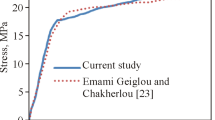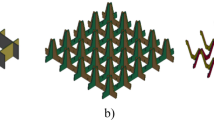The impact behavior of sandwich structures was studied using experimental and numerical methods. Polypropylene with 0.5 wt% of graphene (PP/0.5% G) or pure polypropylene (PP) was sandwiched between aluminum face sheets for experimental tests. Impact tests revealed that the nanoreinforced structures had a higher contact force and a shorter contact duration than pure core structures. Both the damage area and the dent depth were lower for nano-reinforced structures. More energy absorbed the pure structures. The higher absorbed energy can be explained by the higher amount of damage that occurred in the structure. To further investigate the impact response of the sandwich structures, a three-dimensional quarter model was developed and implemented in the ABAQUS software. The strain-rate-dependent behavior of the core and face sheets was investigated using the Johnson–Cook material model to simulate the impact behavior of aluminum, PP, and G/PP layers. Simulation results were compared with experimental data, and a good agreement between them was found to exist. The validated finite-element model was used for studying the effects of geometrical and material parameters, including the thickness of aluminum and PP layers, different weight ratios of nanoparticles, and different mechanical properties of the aluminum layers, on the impact response of sandwich structures. By introducing graphene up to 0.5 wt% into the PP material, all of the impact outputs reached their extremum amounts, which were considerably affected by the yield strength and elastic modulus of aluminum layers.











Similar content being viewed by others
References
M. Altan, M. Bayraktar, and B. Yavuz, “Manufacturing polymer/metal macro-composite structure for vibration damping,” Int. J. Adv. Manuf. Tech., 86, 2119-2126 (2016).
H. Khoramishad and M. Bagheri Tofighi, “Effects of mechanical and geometrical properties of adhesive and metal layers on low-velocity impact behavior of metal laminate structures,” J. Adhes. Sci. Technol., 29, 592-608 (2015).
H. Khoramishad, M. Bagheri Tofighi, and M. Khodaei, “Effect of stacking sequence on low-velocity impact behavior of metal laminates,” Phys. Mesomech., 21, 140-149 (2018).
A. Riccio, A. Raimondo, A. Sellitto, V. Acanfora, and M. Zarrelli, “Multifunctional polypropylene core for aerospace sandwich composite panels,” Procedia. Eng., 167, 64-70 (2016).
M. Bulut, “Low-velocity impact tests on basalt fiber/polypropylene core honeycomb sandwich composites,” Mech. Compos. Mater., 56, 121-130 (2020).
M. V. Hosur, A. A. Mohammed, and S. Jeelani, “Impact Response of Nanophased Polyurethane Foam Core Sandwich Composites,” In: 16th International Conference on Composite Materials (ICCM-16), Kyoto, 8-13 July, 1-7, (2007).
M. V. Hosur, A. A. Mohammed, S. Zainuddin, and S. Jeelani, “Processing of nanoclay filled sandwich composites and their response to low-velocity impact loading,” Compos. Struct., 82, 101-116 (2008).
M. V. Hosur, A. A. Mohammed, S. Zainuddin, and S. Jeelani, “Impact performance of nanophased foam core sandwich composites,” Mater. Sci. Eng., 498, 100-109 (2008).
M. A. Bhuiyan, M. V. Hosur, and S. Jeelani, “Low-velocity impact response of sandwich composites with nanophased foam core and biaxial (±45°) braided face sheets,” Compos. Part B-Eng., 40, 561-571 (2009).
A. F. Avila, M. G. R. Carvalho, E. C. Dias, and D. T. L. Cruz, “Nano-structured sandwich composites response to lowvelocity impact,” Compos. Struct., 92, 745-751 (2010).
P. N. B. Reis, P. Santos, J. A. M. Ferreira, and M. O. W. Richardson, “Impact response of sandwich composites with nano-enhanced epoxy resin,” J. Reinf. Plast. Compos., 32, 898-906 (2013).
I. Taraghi and A. Fereidoon, “Non-destructive evaluation of damage modes in nanocomposite foam-core sandwich panel subjected to low-velocity impact,” Compos. Part B-Eng., 103, 51-59 (2016).
K. R. Ramakrishnan, S. Guerard, Z. Zhang, K. Shankar, and P. Viot, “Numerical modeling of foam-core sandwich panels with nano-reinforced composite facesheets,” J. Sandw. Struct. Mater., 0, 1-26 (2019).
S. Feli and M. M. Jalilian, “Three dimensional solution of low velocity impact on sandwich panels with hybrid nanocomposite face sheets,” Mech. Adv. Mater. Struc., 25, 579-591 (2018).
S. Jedari Salami, “Low velocity impact response of sandwich beams with soft cores and carbon nanotube reinforced face sheets based on extended high order sandwich panel theory,” Aerosp. Sci. Technol., 66, 165-176 (2017).
F. Vakili-Tahami, M. R. Adibeig, and S. Hassanifard, “Optimizing creep lifetime of friction stir welded PMMA pipes subjected to combined loadings using rheological model,” Polym. Test., 79, 106049 (2019).
J. H. Ku, I. H. Jung, K. Y. Rhee, and S. J. Park, “Atmospheric pressure plasma treatment of polypropylene to improve the bonding strength of polypropylene/aluminum composites,” Compos., Part B-Eng., 45, 1282-1287 (2013).
M. M. Shokrieh and V. Ahmadi Joneidi, “Characterization and simulation of impact behavior of graphene/polypropylene nanocomposites using a novel strain rate–dependent micromechanics model,” J. Compos. Mater., 49, 2317-2328 (2014).
A. V. Pocius, “The electrochemistry of the FPL (Forest Products Laboratory) process and its relationship to the durability of structural adhesive bonds,” J. Adhes., 39, 101-121 (1992).
URL: https://imagej.nih.gov/ij/index.html (reference date: 06.12.2021).
R. K. Goldberg, G. D. Roberts, and A. Gilat, “Implementation of an associative flow rule including hydrostatic stress effects into the high strain rate deformation analysis of polymer matrix composites,” J. Aerospace Eng., 18, 18-27 (2005).
M. M. Shokrieh, R. Mosalmani, and M. J. Omidi, “Strain rate dependent micromechanical modeling of reinforced polymers with carbon nanotubes,” J. Compos. Mater., 48, 3381-3393 (2013).
Z. Emami Geiglou and T. N. Chakherlou, “Numerical and experimental investigation of the effect of the cold expansion process on the fatigue behavior of hybrid (bonded-bolted) double shear lap aluminum joints,” Int. J. Fatigue., 126, 30-43 (2019).
Author information
Authors and Affiliations
Corresponding author
Additional information
Russian translation published in Mekhanika Kompozitnykh Materialov, Vol. 58, No. 2, pp. 297-320, March-April, 2022. Russian DOI: https://doi.org/10.22364/mkm.58.2.04.
Rights and permissions
About this article
Cite this article
Tofighi, M.B., Biglari, H. & Shokrieh, M.M. An Experimental and Numerical Investigation on the Low-Velocity Impact Response of Nanoreinforced Polypropylene Core Sandwich Structures. Mech Compos Mater 58, 209–226 (2022). https://doi.org/10.1007/s11029-022-10022-5
Received:
Revised:
Published:
Issue Date:
DOI: https://doi.org/10.1007/s11029-022-10022-5




